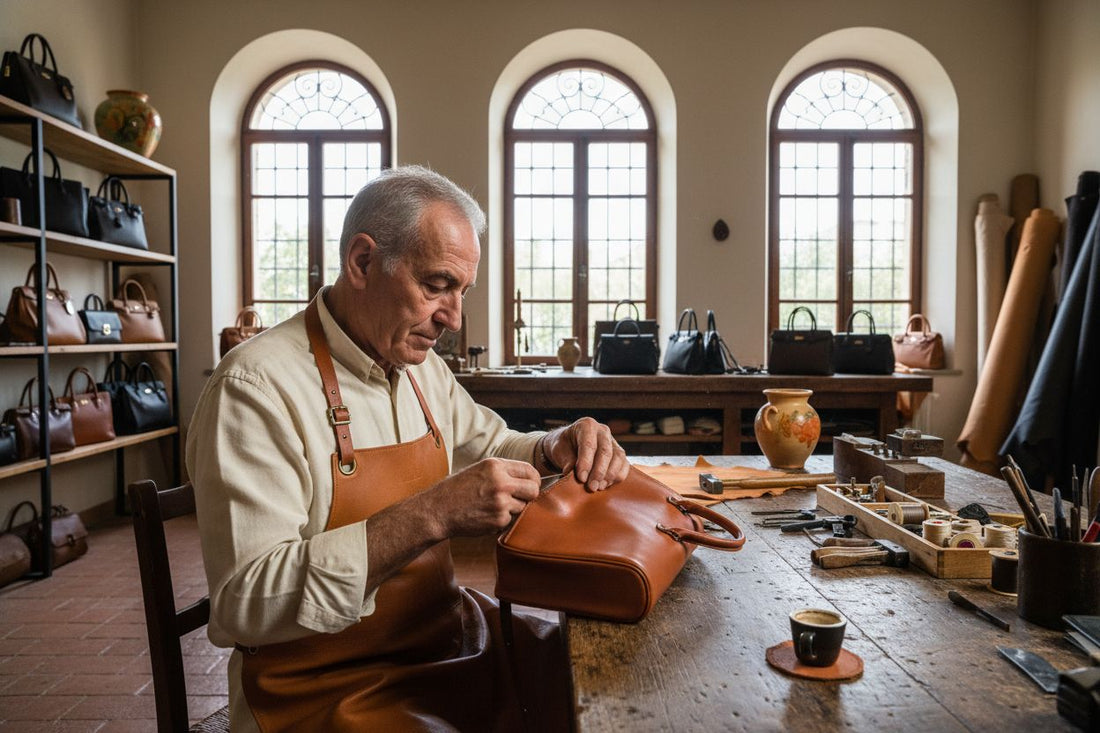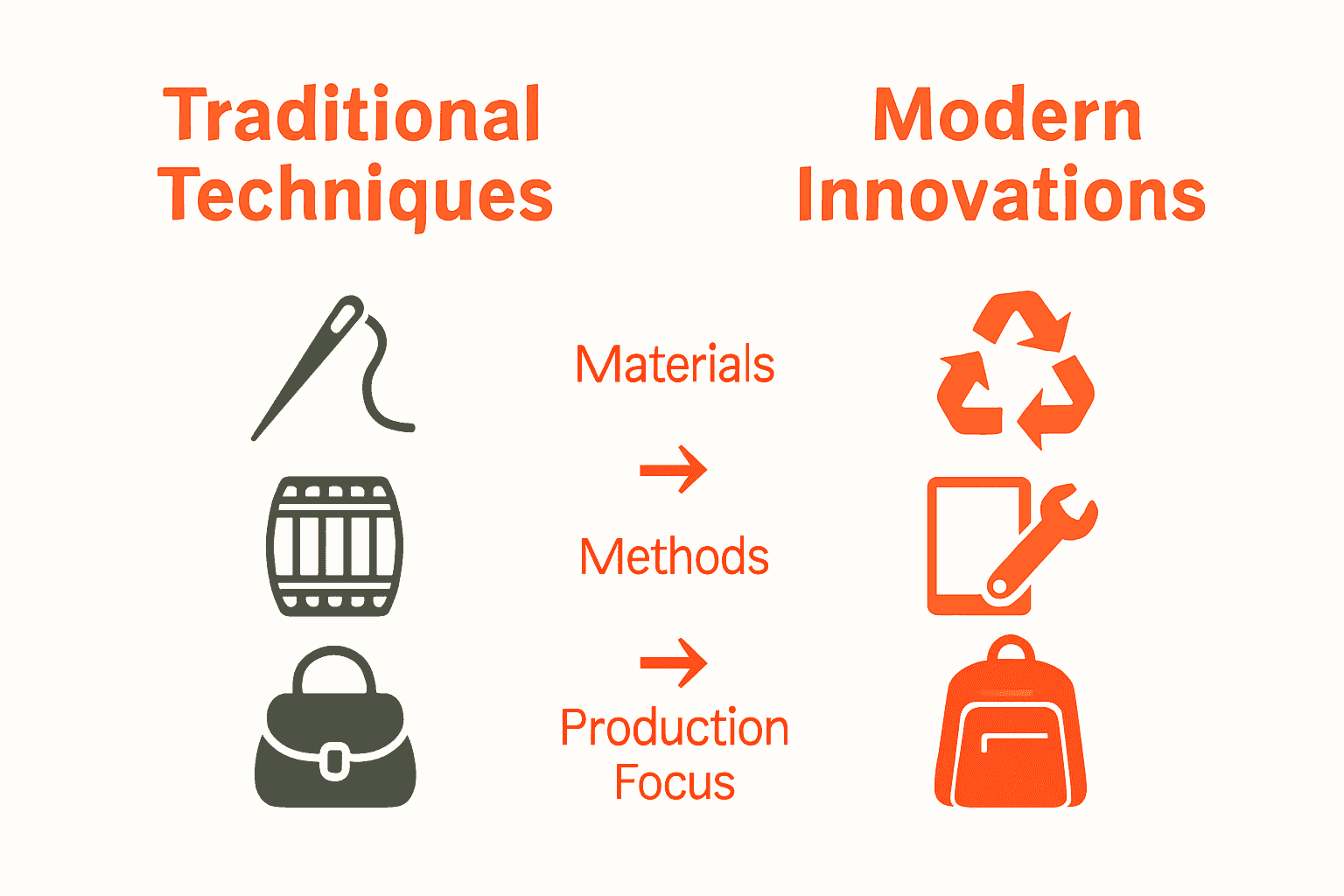
The Essential Guide to Italian Handbag Making History
Share
Did you know that some Italian leather artisans have been perfecting their skills for over seven centuries? This rich tradition has shaped not only the look but also the meaning of luxury handbags around the globe. Italy’s legendary workshops, famed for hand-stitching and meticulous attention to detail, have turned simple leather into cultural icons. Discover how old-world craftsmanship has blended with modern design to create handbags that are treasured across generations.
Key Takeaways
| Point | Details |
|---|---|
| Historical Significance | Italian handbag craftsmanship originates from medieval traditions, with cities like Florence and Venice establishing key artisanal techniques. |
| Artistry Meets Innovation | The evolution of designs reflects a blend of traditional craftsmanship and modern technologies, shaping a unique narrative in luxury fashion. |
| Sustainable Practices | There is a strong shift towards sustainability in Italian craftsmanship, emphasizing ethical production and lasting quality over fast fashion. |
| Cultural Impact | Italian handbags serve as global symbols of luxury, merging artistry with cultural significance, influencing fashion trends worldwide. |
Table of Contents
- Origins Of Italian Handbag Craftsmanship
- Evolution Of Styles And Materials In Italy
- Role Of Artisans And Family-Owned Workshops
- Traditional Techniques Versus Modern Innovations
- Impact On Global Luxury And Slow Fashion
Origins Of Italian Handbag Craftsmanship
Italian handbag craftsmanship is a story woven through centuries of extraordinary artisan tradition. The roots of this remarkable craft trace back to medieval Italy, where cities like Florence and Venice emerged as pioneering centres of leather manufacturing and design. According to historical research from the history of Italian bags guide, these regions developed sophisticated techniques that would transform leather accessories from mere functional items into exquisite works of art.
During the medieval period, specialised artisan guilds played a pivotal role in establishing quality standards and protecting trade secrets. In Florence, the Arte dei Cuoiai (Leather Workers Guild) was founded in 1282, creating structured frameworks that ensured meticulous craftsmanship. Specific city quarters like Via dei Borsai became dedicated spaces where skilled leather artisans would gather, design, and produce intricate leather goods. These guilds were more than professional associations - they were guardians of a craft that would become synonymous with Italian excellence.
The Renaissance marked a transformative period for leather accessory design. Wealthy patrons began commissioning leather accessories that transcended pure utility, elevating bags into symbols of social status and artistic expression. Artisans in Florence and Venice refined tanning techniques, developed innovative decorative methods, and started creating leather goods that were as much about aesthetic beauty as functional design. This period laid the groundwork for what would become Italy’s global reputation for unparalleled leather craftsmanship - a legacy that continues to define luxury leather goods today.
Key characteristics of early Italian handbag craftsmanship included:
- Meticulous hand-stitching techniques
- Exceptional leather selection and treatment
- Intricate decorative embellishments
- Commitment to durability and aesthetic elegance
Evolution Of Styles And Materials In Italy
The journey of Italian handbag design represents a remarkable narrative of continuous innovation and artistic expression. From medieval utilitarian accessories to sophisticated contemporary designs, Italian craftsmanship has consistently pushed the boundaries of fashion and functionality. According to research on Italian bag history, the evolution of these accessories reflects profound cultural and technological transformations.
The mid-20th century marked a pivotal moment in handbag design. Iconic fashion houses like Gucci, Prada, and Fendi began revolutionizing accessory design during the 1950s and 1960s. They introduced groundbreaking styles that would become global design landmarks. For instance, the Gucci Bamboo Bag emerged as a symbol of innovative craftsmanship, while the Fendi Baguette represented a new approach to luxury accessories that blended functionality with sophisticated aesthetics.
Recent decades have seen even more radical transformations in materials and design philosophy. Contemporary Italian designers have embraced sustainable practices and cutting-edge technologies. Brands like Bottega Veneta introduced revolutionary designs such as the woven Cabat bag in 2001, demonstrating extraordinary material manipulation techniques. The Valentino Rockstud, introduced in 2010, further showcased Italy’s ability to create accessories that are simultaneously avant-garde and timeless.

Key milestones in Italian handbag evolution include:
- Transition from purely functional leather goods
- Introduction of luxury design elements
- Incorporation of innovative manufacturing techniques
- Emphasis on sustainable and technologically advanced materials
Role Of Artisans And Family-Owned Workshops
The soul of Italian handbag craftsmanship lies deeply rooted in family-owned workshops and generational artisanal practices. These intimate ateliers have been the beating heart of Italy’s leather goods industry, preserving techniques that transform simple materials into extraordinary accessories. According to research on Italian leather handbag traditions, these workshops have maintained trade knowledge and exceptional quality standards for centuries.
Legendary brands like Bottega Veneta exemplify how family craftsmanship shapes design innovation. Their signature Intrecciato weaving technique, developed by founding artisans, represents more than a manufacturing process - it’s a testament to generational skill and artistic vision. Similarly, brands such as Roberta di Camerino, founded by Giuliana Camerino in post-World War II Venice, demonstrate how individual artisan families can create lasting design legacies that transcend generations.
Florentine educational institutions like the Scuola del Cuoio play a crucial role in preserving and transmitting these intricate craftsmanship traditions. These schools ensure that the nuanced skills of leather working continue to be passed down, maintaining the extraordinary standards that have made Italian leather goods globally renowned. Family workshops are not just manufacturing units; they are living repositories of cultural heritage, where each stitch tells a story of tradition, innovation, and uncompromising quality.
Key characteristics of Italian family-owned artisan workshops include:
- Preservation of ancestral leather crafting techniques
- Commitment to handmade, detail-oriented production
- Emphasis on passing knowledge through generations
- Integration of traditional methods with modern design sensibilities
Traditional Techniques Versus Modern Innovations
Italian handbag craftsmanship represents a delicate dance between time-honored traditions and contemporary technological advancements. Traditional techniques remain the foundation of leather goods production, with artisans continuing to employ methods passed down through generations. According to Italian handbag craftsmanship insights, these techniques include intricate processes like hand-skiving, manual pattern cutting, and meticulous hand-stitching that define the essence of true artisanal work.
Historic methods such as vegetable tanning continue to play a crucial role in maintaining the authenticity of Italian leather production. Contemporary designers have ingeniously integrated modern innovations that complement rather than replace traditional craftsmanship. This approach allows for the introduction of smart-tech features and sustainable materials while preserving the core artistic techniques that have defined Italian leather goods for centuries. From advanced ergonomic designs to eco-friendly production processes, modern innovations are carefully woven into the fabric of traditional craftsmanship.
The most successful Italian handbag makers have mastered the art of balance - respecting ancestral techniques while embracing technological possibilities. This delicate equilibrium ensures that each piece tells a story of heritage and innovation. Advanced materials like recycled leathers, smart tracking technologies, and sustainable manufacturing processes are now seamlessly integrated with hand-finishing techniques that have remained unchanged for generations.
Key aspects of the traditional versus modern approach include:

Here’s a comparison of traditional techniques and modern innovations in Italian handbag craftsmanship:
| Aspect | Traditional Techniques | Modern Innovations |
|---|---|---|
| Materials | Hand-selected leather | Recycled leathers Sustainable fabrics |
| Craft Methods | Hand-stitching Manual cutting |
Smart-tech integration 3D design |
| Tanning | Vegetable tanning | Eco-friendly processes |
| Decorative Elements | Embroidery Hand-tooling |
Laser-cutting Digital embellishment |
| Focus | Heritage Durability |
Sustainability Technological advancement |
| Production Scale | Small batch Artisan workshops |
Broader capability Global reach |
- Preservation of hand-crafting skills
- Integration of sustainable materials
- Incorporation of smart-tech features
- Maintaining artisanal quality standards
- Balancing technological innovation with cultural heritage
Impact On Global Luxury And Slow Fashion
Italian handbag craftsmanship has profoundly reshaped global perceptions of luxury, transforming accessories from mere functional items into cultural statements of artistry and sustainability. According to sustainable luxury insights, these hand-crafted pieces represent a radical departure from mass production, with artisans investing an extraordinary 15-20 hours into creating each unique bag. This commitment to slow fashion represents more than a manufacturing process - it’s a philosophical approach that prioritizes quality, tradition, and environmental consciousness.
Iconic Italian designs have become global ambassadors of luxury and craftsmanship. Bags like the Gucci Bamboo, Fendi Baguette, Bottega Veneta Cabat, and Valentino Rockstud have transcended mere accessories to become cultural symbols. These pieces demonstrate how Italian design merges technical excellence with profound artistic expression, influencing fashion trends worldwide and setting new standards for what luxury truly means. Each bag tells a story of generational skill, innovative design, and uncompromising quality.
The global impact of Italian handbag craftsmanship extends far beyond aesthetic appeal. By championing slow fashion principles, Italian artisans have challenged the disposable culture of fast fashion, emphasizing durability, timeless design, and ethical production. This approach has inspired a global movement towards more conscious consumption, where consumers increasingly value provenance, craftsmanship, and sustainability over rapid trend cycles. Italian leather goods have become emblematic of a broader shift towards more responsible, meaningful fashion choices.
Key contributions of Italian handbag craftsmanship to global luxury include:
- Redefining luxury as an experience, not just a product
- Championing sustainable and ethical manufacturing
- Preserving traditional artisanal techniques
- Creating culturally significant design narratives
- Inspiring a global slow fashion movement
Experience True Italian Craftsmanship With San Rocco Italia
Have you ever felt that mass-produced handbags lack the soul and history you read about in our guide to Italian handbag making? If you are searching for accessories that genuinely reflect timeless design and heritage artisan techniques, your journey begins here. At San Rocco Italia, we embrace the same meticulous standards and family-led traditions highlighted throughout your exploration of Italy’s legendary craftsmanship.

Discover what sets genuine Italian leather goods apart from fleeting fast fashion. Our collections feature handmade handbags and accessories created in Italy by expert artisans, using premium full-grain leather and techniques safeguarded through generations. Each San Rocco piece is an authentic expression of the unrivalled skill described in the article, and offers you the assurance of quality, sustainability and distinctive European flair. Visit our website San Rocco Italia now to explore our world of legacy-made luxury, and experience how heritage and artistry converge in every accessory. The best moment to invest in true craftsmanship is right now—your celebration of Italian artistry starts here.
Frequently Asked Questions
What are the origins of Italian handbag craftsmanship?
Italian handbag craftsmanship can be traced back to medieval Italy, especially in cities like Florence and Venice, where artisan guilds established standards of quality and transformed leather goods into works of art.
How has Italian handbag design evolved over the years?
The evolution of Italian handbag design has moved from purely functional accessories in the medieval period to sophisticated luxury items thanks to the influence of iconic fashion houses and advancements in materials and techniques throughout the 20th and 21st centuries.
What role do family-owned workshops play in Italian handbag craftsmanship?
Family-owned workshops are crucial as they preserve traditional crafting techniques and quality standards, often passing down skills through generations, which helps maintain the artistry and uniqueness of Italian leather goods.
How do traditional techniques compare to modern innovations in handbag making?
Traditional techniques involve methods like hand-stitching and vegetable tanning, while modern innovations incorporate sustainable materials and smart technologies. The best artisans blend these approaches to maintain quality while embracing innovation.


